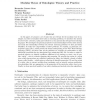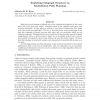JAIR
2008
13 years 11 months ago
2008
It has been widely observed that there is no single "dominant" SAT solver; instead, different solvers perform best on different instances. Rather than following the trad...
JAIR
2008
13 years 11 months ago
2008
JAIR
2008
13 years 11 months ago
2008
In this paper we introduce MINIMAXSAT, a new Max-SAT solver that is built on top of MINISAT+. It incorporates the best current SAT and Max-SAT techniques. It can handle hard claus...
JAIR
2008
13 years 11 months ago
2008
In this paper, we propose a set of tasks that are relevant for the modular reuse of ontologies. In order to formalize these tasks as reasoning problems, we introduce the notions o...
JAIR
2008
13 years 11 months ago
2008
We represent planning as a set of loosely coupled network flow problems, where each network corresponds to one of the state variables in the planning domain. The network nodes cor...
JAIR
2008
13 years 11 months ago
2008
Probabilistic planning problems are typically modeled as a Markov Decision Process (MDP). MDPs, while an otherwise expressive model, allow only for sequential, non-durative action...
JAIR
2008
13 years 11 months ago
2008
We present three new complexity results for classes of planning problems with simple causal graphs. First, we describe a polynomial-time algorithm that uses macros to generate pla...
JAIR
2008
13 years 11 months ago
2008
Multi-robot path planning is difficult due to the combinatorial explosion of the search space with every new robot added. Complete search of the combined state-space soon intracta...
JAIR
2008
13 years 11 months ago
2008
Gesture is a non-verbal modality that can contribute crucial information to the understanding of natural language. But not all gestures are informative, and non-communicative hand...
JAIR
2008
13 years 11 months ago
2008
Reasoning about agent preferences on a set of alternatives, and the aggregation of such preferences into some social ranking is a fundamental issue in reasoning about multi-agent ...


